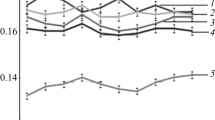Abstract
The tribological behaviours of woven fabrics made from Kevlar® (DuPont's registered trademark) yarns of different linear densities were compared with the friction properties of their constituent yarns with different surface treatments. The latter were examined with a traditional friction meter, and the woven fabrics were studied with a pin-on-disc tribometer in alternate and continuous sliding mode. Scoured fabrics, a poly(tetrafluoroethylene)-coated fabric, and fabrics made of surface-treated yarns (polysiloxane oil, hydrophobic paraffin or ester oil lubricant) were compared. These treatments are not representative of commercial Kevlar® yarn finishes but are suitable models for simulating various tribological situations. Both the yarn texture and the surface treatment have an influence on friction coefficient values. Relative humidity affects the friction coefficient only in the case of hydrophilic surfaces, whereas hydrophobic surfaces exhibit fairly constant tribological characteristics. The largest impact on friction seems to be evidenced by the linear density factor. This comparative tribological analysis could lead the way to correlations between yarn friction, weaving performance and woven structure tribological characteristics.
Similar content being viewed by others
References
B. J. BRISCOE and F. MOTAMEDI, Wear 158 (1992) 229.
T. KATO and A. MAGARIO, Tribol. Trans. 37 (1994) 559.
S. K. SINHA and S. K. BISWAS, J. Mater. Sci. 27 (1992) 3085.
K. FRIEDRICH, “Friction and wear of polymer composites” (Elsevier, Amsterdam, 1986).
S. REBOUILLAT, Polymer 38(9) (1997) 2245.
S. REBOUILLAT, M. ESCOUBES and R. GAUTIER, J. Adhes. Sci. Technol. 7 (1995) 635.
A. MARTINEZ, C. NAVARRO, R. CORTES, J. RODRIGUEZ and A. SANCHEZ-GALVEZ, J. Mater. Sci. 28 (1993) 1305.
L. LAVIELLE, Wear 15 (1991) 63.
B. D. TAPLEY, “Handbook of engineering fundamentals” (Wiley, New York, 1990).
A. C. DIENG, G. RIESS and L. LAVIELLE, in Proceedings of the International Tribology Conference, Perth 5–8 December 1994 (1994) pp. 533–537.
M. SHUBHA, H. V. PATIMOLA and K. VIYAJAN, J. Mater. Sci. Lett. 12 (1993) 60.
Author information
Authors and Affiliations
Rights and permissions
About this article
Cite this article
Rebouillat, S. Tribological properties of woven para-aramid fabrics and their constituent yarns. Journal of Materials Science 33, 3293–3301 (1998). https://doi.org/10.1023/A:1013225027778
Issue Date:
DOI: https://doi.org/10.1023/A:1013225027778




